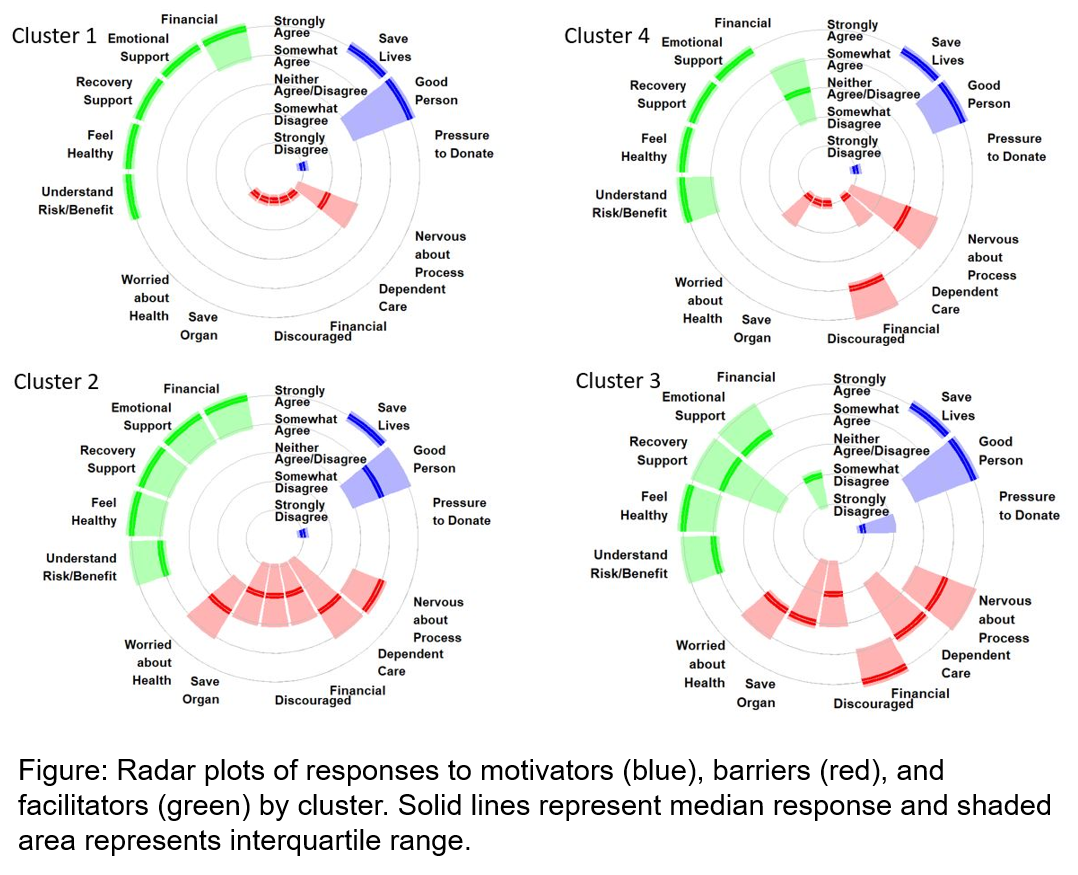Interaction Between Financial Barriers and Other Motivators, Barriers, and Facilitators of Living Organ Donation
A. R. Smith1, R. J. Mandell1, M. E. Helmuth1, N. P. Goodrich1, J. B. Wiseman1, K. A. Gifford2, M. A. Fava1, A. O. Ojo3, R. M. Merion1, A. K. Mathur4
1Arbor Research Collaborative for Health, Ann Arbor, MI, 2American Society for Transplant Surgeons, Arlington, VA, 3University of Kansas Medical Center, Kansas City, KS, 4Mayo Clinic, Phoenix, AZ
Meeting: 2022 American Transplant Congress
Abstract number: 1742
Keywords: Kidney transplantation, Living donor, Psychosocial, Public policy
Topic: Clinical Science » Kidney » 50 - Health Equity and Access
Session Information
Session Time: 7:00pm-8:00pm
 Presentation Time: 7:00pm-8:00pm
Presentation Time: 7:00pm-8:00pm
Location: Hynes Halls C & D
*Purpose: Our objective was to assess how financial barriers to living donation interact with other motivators, barriers, and facilitators during the decision-making process.
*Methods: Data were obtained from a public survey developed to assess the impact of lost wage reimbursement on the decision to initiate living donor evaluation. The survey is a 30-item questionnaire addressing motivators, barriers, and facilitators of living organ donation. Interactions between financial barriers and other motivators, barriers, and facilitators were explored using multivariable logistic regression and consensus k-means clustering.
*Results: From March 2020 to November 2021, 1150 respondents across the decision-making spectrum completed the survey; the average age was 42; 74% were female and 14% and 5% identified as Hispanic and Black, respectively, with 69% identifying as white. Among employed respondents (71%), 39% indicated that they would not be able to donate without lost wage reimbursement. Respondents that rated stronger agreement with worries about health and dependent care challenges had higher odds of not being able to donate without lost wage reimbursement (OR=1.2, 95% CI 1.1-1.4; OR=1.1, 95% CI 1.0-1.3, respectively). Unsupervised clustering revealed 4 clusters (Figure). Cluster 1 was ready to initiate evaluation. Cluster 2 was characterized by barriers related to worries about health, nervousness, and dependent care. Clusters 3 and 4 had financial barriers, and Cluster 3 additionally had barriers related to nervousness about the process and dependent care.
*Conclusions: Financial barriers interact primarily with concerns about health and dependent care when considering living organ donation. These results imply that both efforts to reduce financial barriers as well as targeted additional education about the risk and benefits of the donation process are needed for potential living donors.
To cite this abstract in AMA style:
Smith AR, Mandell RJ, Helmuth ME, Goodrich NP, Wiseman JB, Gifford KA, Fava MA, Ojo AO, Merion RM, Mathur AK. Interaction Between Financial Barriers and Other Motivators, Barriers, and Facilitators of Living Organ Donation [abstract]. Am J Transplant. 2022; 22 (suppl 3). https://atcmeetingabstracts.com/abstract/interaction-between-financial-barriers-and-other-motivators-barriers-and-facilitators-of-living-organ-donation/. Accessed November 26, 2025.« Back to 2022 American Transplant Congress

